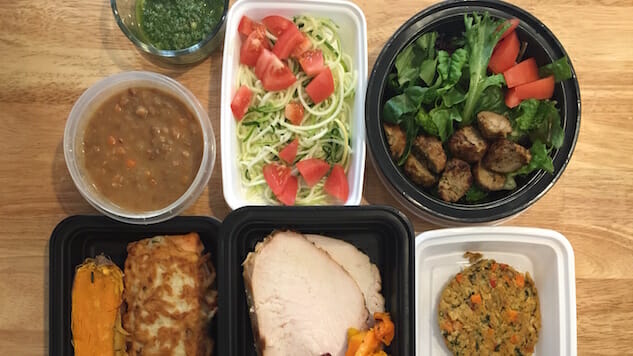
It’s Monday morning and you’re running late. You open the fridge to grab something quick to pack for lunch and realize there’s nothing ready to go so you settle for buying lunch, yet once again. Does this scenario sound familiar?
If you’re anything like me, this lack of planning usually means healthy eating might not happen. Thinking about your meals for the week and making sure you have all the supplies and ingredients needed to make them, is often the only way it ever gets done. By planning, making, and storing your meals ahead of time, you can save time, money, calories and stress. If you’re just starting out, meal prep may seem a bit overwhelming, but with a few tips and a little practice, you’ll be whipping up weekly meals in no time.
1. Choose your food/meals
Spend some time online googling recipes and other meal prep sites that have already done the work for you. Once you have found some basic plans and meals you like, print them out and keep in a notebook close to your kitchen. If you are a Pinterest user, create a meal prep board and pin them there for easy access.
2. Invest in some quality food storage containers
Make sure you buy a variety of sizes and look for ones with lids that snap. Also pick up some quart and gallon size ziplock bags for marinating and freezer storage and various sizes of glass mason jars.
3. Create your shopping list
The internet is loaded with ideas for this and there are endless apps for your phone that will generate lists for your individual needs.
4. Go shopping
If at all possible, buy in bulk. Once you’ve had a few successful weeks of meal prep, you will know exactly what you need to buy and in what quantity, which will save time and money.
5. Pick a day and time to cook
Most people prefer Sunday if they work a traditional Monday to Friday work week, but you need to prep and cook on whatever day makes the most sense for you. Spend your meal prep time cooking multiple dishes at the same time so you have options to choose from throughout the week.
6. Meal prep ideas
Casseroles, crock pot meals, grilled chicken breasts (chopped up and whole), cooked ground beef and turkey, rice, chopped veggies and fruit stored in individual ziplock bags, salad fixings, cooked sweet potatoes/yams, quinoa, burrito bowls, chicken lettuce wraps, pasta salad, beans, overnight oats, ingredients for smoothies, and yogurt granola parfaits.
7. Store in containers and label
Individual use, family style, grab and go, snacks, and home meals. Meals can be combined with fruits a vegetables in one container for a healthy grab and go.
![]()
Prepping like a pro
There are countless menu ideas to make meal prep simple and tasty, but sometimes just getting started can feel overwhelming. If you want to give this whole meal prep a test drive, starting with lunch and choosing something basic like a salad, is an easy way to see if this method will work for you.
Sample meal prep: Salads for lunch
Salads are one of the most versatile and easy to pack lunches and there are a variety of mixtures to choose from. Having a combination of some core ingredients in your kitchen can make it a snap to throw this healthy meal together at the last minute. Chicken caesar salad (with low fat dressing), greek salad, shrimp salad, black bean salad, or a salmon and mixed greens salad are just a few of the more popular choices when searching for ideas.
Before you head to the grocery store, sit down and make a list of the salad fixings that you like best and think of different ways you can mix and match them. The following ingredients are the most popular choices for power salads:
Combination of mixed greens: romaine, red and green leaf, spinach, and shredded lettuce.
Chopped vegetables: tomatoes, peppers (red, yellow, green, orange), onions, broccoli, cucumbers, carrots, mushrooms, peas, beets, olives, radishes (think rainbow colors)
Protein: grilled chicken, salmon, lean flank steak, chopped egg, shrimp, crab, ground turkey or hamburger, quinoa
Beans: black, kidney, lima, cannellini, great northern, chickpeas
Nuts and seeds: walnuts, slivered almonds, pumpkin seeds, pecans
Dressings: dressings are very individual and can range from an oil and vinegar based to a creamy dairy based—some people even prefer to let the natural juices of the vegetables act as the dressing.
Mason Jar Salad
Using a mason jar to layer and store your salads is a great way to pack ahead of time and grab and go in the morning. The secret to making a mason jar salad is in the layering. The following steps are in order from bottom to top of the jar:
Dressing on the bottom
Base layers: begin adding your salad ingredients and focus first on layering ones that won’t soak up the dressing such as cherry tomatoes, chickpeas, carrots, sugar snap peas
Continue with base layers: add other vegetables and beans such as radishes, corn, olives, cucumbers, onions, peppers, beets, black beans and kidney beans. Pack the layers tight to keep the salad fresh.
Top it off: finish with your mixed greens, cheese, etc.,
Seal, store and eat: put the lid on and tighten it. Store in the fridge until you are ready to eat or pack for work. Have your protein source and nuts ready to go in a separate container and add when you are ready to eat.
Image: Wellness Wildflower, CC-BY
Sara Lindberg is a freelance writer specializing in health, fitness, and wellness.